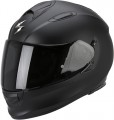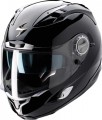Size
The sizes in which this helmet model is produced.
The appropriate helmet size depends primarily on the circumference of the wearer's head. The circumference is measured at the widest point of the head — usually at a level of 1 – 2 cm above the eyebrows and along the protrusion at the back of the head; more detailed recommendations and descriptions can be found in special sources. Here we note that although manufacturers use the same size designations —
XXS,
XS,
S,
M,
L,
XL, etc. — specific sizes for different brands may vary slightly; for example, XL can fit both 60 – 61 cm and 61 – 62 cm. This seemingly small difference can significantly affect the comfort and safety of use. Therefore, when choosing, you need to be guided by the size tables of a particular manufacturer.
It is also worth considering that helmets with the same size designation may differ not only in actual size, but also in the shape of the internal space. Therefore, even compliance with the size table is not a guarantee that the product will be suitable; the most reliable way is to test the helmet "live" before buying.
Fastener
A type of fastener used on a motorcycle helmet to secure a chinstrap.
—
D-Rings. A classic clasp that is still popular today due to its combination of simplicity and reliability. The basis of the design is a pair of D-shaped rings (hence the name). When properly applied, these rings firmly clamp the belt passed through them, and the free end of the belt is fixed to the clasp-button or magnet. In addition to a secure hold, the advantages of D-Rings include the fact that size adjustment is made on the fly every time, directly when fastening; this is especially convenient for a "passenger" helmet, which has to be used by different people. On the other hand, the fastening-unfastening process itself is not very convenient: it requires a certain habit and takes more time than in other fasteners.
—
Quick click. The classic Quick-Click design resembles a car seat belt buckle: on one half there is a metal plate with a hole, on the other there is a lock that automatically fixes this plate and opens at the touch of a button. It is believed that such fasteners are less reliable than D-Rings, however, with proper workmanship, this difference is not significant; and fasten and unfasten Quick-Click much faster and more convenient. Also in this category are "fastex" — fasteners, familiar to many from tourist equipment. "Fastex" has the form of a trident, fixed in a special nest, such a lock opens by
...pressing from the sides; this variety has not received much distribution, as it is considered not very reliable.
— Ratchet. Also known as Quick-Release. One half of such a clasp looks like a strap (usually plastic) with a special notch, a lock is installed on the second. The strap can move through the closed lock only in one direction — to tighten, this is how the “ratchet” fastens (with a characteristic sound, hence the name). To unfasten it, you need to open the lock, giving the strap the opportunity to move in the opposite direction. This design allows you to quickly and easily remove and put on the helmet, while, like the D-Rings, it automatically adjusts to size with each fastening. At the same time, fasteners are considered not very reliable, but in fact it all depends on the quality of workmanship (which, usually, is directly related to the price category of the helmet).Shell material
The material from which the shell is made is the outer hard shell of the helmet.
—
Thermoplastic. Material used primarily in inexpensive motorcycle helmets; the most popular option in this category. Thermoplastic (most often it is polycarbonate) is notable for its low cost and has quite sufficient, although not very high, strength characteristics, but it is quite heavy, besides, it “ages” with use due to temperature changes and exposure to ultraviolet radiation; These helmets are recommended to be changed every 5 years.
—
Thermoresin. In terms of basic properties, this material is similar to the plastic described above; at the same time, it is more durable and durable, however, it also costs a little more, which accordingly affects the price of helmets.
—
Fibreglass (fibreglass). In this case, we are not talking about pure glass fibre, but about fibreglass — a composite consisting of fibreglass and a plastic base. Sufficiently strong and reliable, but at the same time quite heavy material, used mainly in mid-level helmets.
—
Carbon. It is also carbon fibre — a composite material that combines carbon fibre and a polymer resin base. This combination allows you to achieve lightness and at the same time extremely high strength, but it is not cheap. Therefore, a carbon fibre shell is usually a si
...gn of a premium helmet.
— Fibreglass / Kevlar. The fibreglass described above, supplemented with a composite based on another fibre — Kevlar. Kevlar is not much inferior to carbon in terms of strength, while it costs less, and such material weighs noticeably less than fibreglass, which significantly affects the mass of the entire helmet. In this case, the materials are usually arranged in layers.
— Carbon / fibreglass. Helmets partly made of carbon, partly made of fibreglass; such a shell usually has a "puff" construction. About the features of each of these materials, see above, and their combination allows you to combine the advantages and partially compensate for the shortcomings. So, such combined helmets are cheaper than pure carbon ones, and in terms of strength they may not be inferior to them. However fibreglass is a heavy material, which accordingly affects the weight; however, such helmets still turn out to be quite light.
— Carbon / Kevlar. Helmets that combine carbon and Kevlar in construction — usually in the form of layers that make up the shell. Both of these materials are detailed above, and the combination is remarkable for its high strength and lower cost than pure carbon. At the same time, these helmets are still expensive, and weigh a little more than carbon ones.
